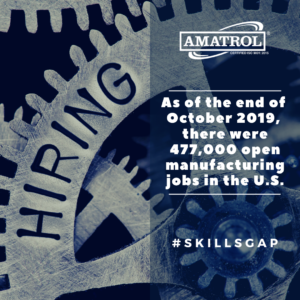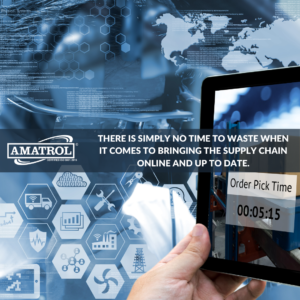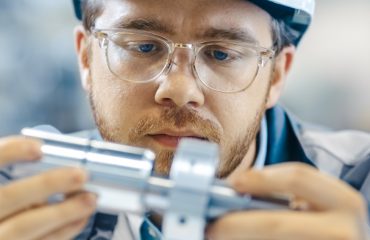
Click HERE to view Supply Chain 4.0: How to Attract and Develop Skilled Workers for the Digital Supply Chain as a multimedia presentation.
The Fourth Industrial Revolution continues to transform the way industries across the board do business today. The technological advances that characterize Industry 4.0 are also reshaping the supply chain, creating a new “Supply Chain 4.0.”
As technology fuels increases in productivity and efficiency throughout manufacturing facilities, the supply chain must not only keep pace with the changes taking place but also seek to anticipate the future needs of an expanding manufacturing sector.
What challenges will the supply chain face? How can the supply chain attract and develop the skilled workers they will need to realize the benefits of Industry 4.0? Amatrol takes a look at these questions and offers potential solutions for those trying to prepare for the supply chain of the future.
 What Is Supply Chain 4.0?
What Is Supply Chain 4.0?
Industries around the world are combining the Internet of Things (IoT) with cyber-physical systems and advanced automation technologies to bring about huge gains in industrial efficiency and productivity. This Fourth Industrial Revolution is in full swing and goes by many names, including Industry 4.0 and Smart Factory.
As the manufacturing world adopts these new technologies, the supply chain must respond accordingly. According to a BDO report, “[t]he arrival of Industry 4.0 is heralding the next era in supply chain management, in which suppliers and customers come together in entirely new ways, blurring the lines between the digital and physical worlds and erasing traditional organizational boundaries.”
The report concludes that “[t]he digitization of the supply chain, or ‘Supply Chain 4.0,’ promises to reduce inefficiencies and lower costs while improving flexibility.” These gains will be accomplished via a variety of new technologies, such as “Big Data and analytics, unprecedented connectivity via machine-to-machine and human-to-machine interaction, 3D printing, automation, artificial intelligence and augmented reality.”
These conclusions about Supply Chain 4.0 technologies and their perceived benefits are shared by others. According to an Automation.com article, the “transition to a digitised network will require integrated planning and execution systems, logistics visibility, autonomous logistics, smart procurement and warehousing, spare parts management and advanced analytics.”
Supply chain consulting company GEP agrees that the benefits of these new Supply Chain 4.0 technologies will be significant:
“Supply chain management, more complex than ever before, stands to benefit tremendously from going digital. Studies suggest that an interconnected, digital supply chain can lower operational costs by more than 30 percent, reduce lost sales opportunities by more than 60 percent, and even reduce inventory requirements by more than 70 percent, all while making companies faster, more agile, granular, accurate, and efficient.”
How Quickly is Supply Chain 4.0 Moving?
To keep pace with the rapid transformations taking place in the advanced manufacturing sector, the supply chain needs to get moving. “There is simply no time to waste when it comes to bringing the supply chain online and up to date,” argues Scott Fawcett in his Automation.com article.
In fact, he notes that a PricewaterhouseCoopers “study revealed that a third of companies surveyed have already started to digitise their supply chains, and 72% of respondents expect to do so in the next five years.”
In order to fully understand the need for an aggressive approach to implementing Supply Chain 4.0 technologies, it’s helpful to look at how large manufacturers are using these technologies to transform their businesses.
For example, PepsiCo is one of the largest manufacturers in North America, “operating more than 100 manufacturing facilities, over 600 warehouses and distribution centers and a fleet of nearly 59,000 vehicles across its three North America Divisions,” according to an article by The Manufacturing Institute.
As noted in a Forbes article, “[o]ne business who realized that using artificial intelligence (AI) and machine learning is a business need, no longer a competitive advantage is PepsiCo…From robots to machine learning, PepsiCo uses AI and machine learning throughout the organization in many ways.”
According to a Digital Commerce 360 article, PepsiCo “is adding digital capabilities to its supply chain and network of distributors and retailers. At the digital forefront is Frito-Lay, which is testing new technology and digital services to better automate its supply chain.”
More specifically, “[a] particularly promising new technology Frito-Lay has deployed is robotics,” including “robotic truck loaders and automated picking.” Another example is “the use of better data analytics to help distributors and retailers track inventory.”
Supply Chain 4.0 Challenges
 As many manufacturers have already learned, however, the gains in efficiency and productivity brought about by advanced technology don’t come without challenges. Today, the biggest challenge facing most industries is a persistent “skills gap” that leaves them with too few highly-skilled workers to implement and maximize available new technologies.
As many manufacturers have already learned, however, the gains in efficiency and productivity brought about by advanced technology don’t come without challenges. Today, the biggest challenge facing most industries is a persistent “skills gap” that leaves them with too few highly-skilled workers to implement and maximize available new technologies.
According to a recent U.S. Bureau of Labor Statistics Job Openings and Labor Turnover Summary (JOLTS) report, there were 477,000 open manufacturing jobs as of the end of October 2019. That’s a lot of open jobs. And it could get worse. The 2018 Deloitte and The Manufacturing Institute Skills Gap and Future of Work Study predicts that more than 2.4 million open manufacturing jobs could go unfilled over the next decade because of the skills gap.
Indeed, the 2019 National Association of Manufacturers (NAM) Manufacturers’ Outlook Survey revealed that “the inability to attract and retain workers remained respondents’ top concern for the eighth consecutive survey.” This mismatch between available workers and the advanced technical skills necessary in a digital supply chain is an obvious cause for concern.
For those looking to bring the supply chain into alignment with manufacturers rapidly adopting Industry 4.0 technologies, it will be a struggle to find workers with the necessary skills to make progress quickly. The challenge thus becomes: how do businesses attract and develop skilled workers for the digital supply chain? Let’s look at two approaches that may help businesses bridge the skills gap.

Attracting New Workers
One way to attract new workers to supply chain careers is to increase interest in these careers, especially among minorities and women. For example, NAM is working hard to change people’s perceptions of careers in manufacturing.
This year, NAM and The Manufacturing Institute are sponsoring the groundbreaking Creators Wanted campaign “to reshape how most Americans view modern manufacturing careers.” The campaign includes a goal of “scaling up bold workforce programs at the Institute to add more veterans, women, diverse communities and youth to manufacturers’ talent pipeline.”
Another initiative of NAM and The Manufacturing Institute intended to boost the perception of manufacturing careers is the annual observation of Manufacturing Day. This initiative allows manufacturers to get involved to show prospective future workers the possibilities their companies offer.
For example, PepsiCo partnered with NAM and The Manufacturing Institute as a Gold-Level Sponsor of Manufacturing Day in 2018. PepsiCo’s Executive Vice President, Global Operations, Grace Puma had this to say:
“Within today’s dynamic marketplace, technological advances are rapid, social paradigms are shifting and consumer demands continue to evolve. We strive to ensure our manufacturing facilities and operations are keeping pace in order to maintain our competitive edge, but also to attract and inspire the next generation of talent to pursue a manufacturing career that is as dynamic as the marketplace we operate in.”
PepsiCo’s efforts extend well beyond Manufacturing Day. According to an IndustryWeek article, “[a]s part of the company’s STEM outreach program, young women at the middle school and high school age are being encouraged to explore STEM careers at PepsiCo. Through its Career Accelerator Days, PepsiCo associates provide middle and high school students, administrators, teachers and parents with exposure to its careers through demonstrations, discussion and hands-on experiences. To date, 6,500 students have been reached with a focus on girls and underserved communities.”
 Teaching Necessary Skills
Teaching Necessary Skills
In addition to attracting more workers to supply chain careers, businesses must ensure that those workers possess the technical and technological skills needed to take advantage of the vast array of advanced technologies Industry 4.0 offers.
At the most basic level, this means investing in STEM education for learners beginning in elementary school. For middle and high school students, CTE programs must be evaluated and improved to make sure they’re teaching in-demand skills that will lead to students filling jobs left open by the skills gap.
In high school and college, students can benefit greatly from obtaining industry-standard certifications that prove they have the skills employers seek. For example, those interested in Supply Chain 4.0 careers will want to explore the new logistics certifications recently announced by the Manufacturing Skill Standards Council (MSSC).
According to MSSC, the new Certified Technician in Supply Chain Automation (CTSCA) logistics certifications “will enable both students and incumbent workers to gain the skills needed to meet the definition of a supply chain automation technician established by the National Science Foundation-funded National Center for Supply Chain Automation: a technician who installs, operates, supports, upgrades or maintains the automated material handling equipment and systems which support the supply chain.”
Businesses can do their part to bridge the skills gap by partnering with local educational institutions to help them understand what opportunities they have, what skills they find most valuable, and which industry-standard certifications they encourage potential workers to pursue.
How Amatrol Can Help
With more than three decades of experience designing and manufacturing state-of-the-art training systems, Amatrol remains the world’s leader in skills-based, interactive technical learning. What truly sets Amatrol apart is its integration of in-depth multimedia eLearning curriculum with hands-on trainers that teach relevant skills with real-world industrial components.
For example, Amatrol recently announced the debut of Skill Boss Logistics, a groundbreaking new supply chain automation training and assessment device for use in conjunction with MSSC’s new CTSCA logistics certifications.
Its compact replication of a full-scale automated sortation system will enable the training of more students and workers for well-paid careers in supply chain automation. It’s also easily transportable and cost effective, making it an ideal solution for a company training facility, a high school CTE classroom, or a community college tech center.
Amatrol also offers other comprehensive Industry 4.0 training systems and programs for both industry and education, including:
These training systems and programs also provide essential preparation for a variety of Industry 4.0 certifications offered by the Smart Automation Certification Alliance (SACA).
In addition to Industry 4.0 training, Amatrol provides a vast array of training systems and programs for advanced manufacturing, including topical areas such as electrical, fluid power, HVAC, mechanical, and more!
Contact Amatrol to learn how you can leverage its technical training expertise to create high-quality training programs that will prepare students and workers for the workplace of the future.
About Duane Bolin
Duane Bolin is a former curriculum developer and education specialist. He is currently a Marketing Content Developer for Amatrol, Inc. Learn more about Amatrol and its technical training solutions, including eLearning, here and connect with Duane on Amatrol’s Twitter, Facebook, LinkedIn, and YouTube pages.






